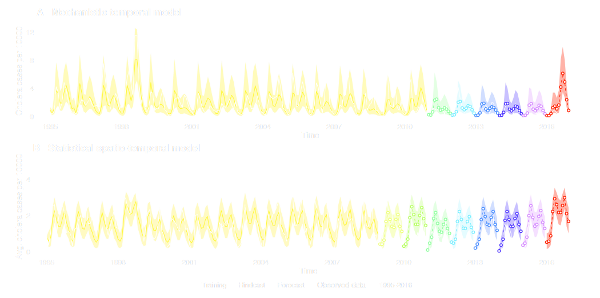Cholera forecast for Dhaka, Bangladesh, with the 2015–2016 El Niño: lessons learned

A substantial body of work supports a teleconnection between the El Niño-Southern Oscillation (ENSO) and cholera incidence in Bangladesh. In particular, high positive anomalies during the winter (Dec-Feb) in sea surface temperatures (SST) in the tropical Pacific have been shown to exacerbate the seasonal outbreak of cholera following the monsoons from August to November. Climate studies have indicated a role of regional precipitation over Bangladesh in mediating this long-distance effect. Motivated by this previous evidence, we took advantage of the strong 2015-2016 El Niño event to evaluate the predictability of cholera dynamics for the city in recent times based on two transmission models that incorporate SST anomalies and are fitted to the earlier surveillance records starting in 1995. We implemented a mechanistic temporal model that incorporates both epidemiological processes and the effect of ENSO, as well as a previously published statistical model that resolves space at the level of districts (thanas). Prediction accuracy was evaluated with “out-of-fit” data from the same surveillance efforts (post 2008 and 2010 for the two models respectively), by comparing the total number of cholera cases observed for the season to those predicted by model simulations eight to twelve months ahead, starting in January each year. Although forecasts were accurate for the low cholera risk observed for the years preceding the 2015-2016 El Niño, the models also predicted a high probability of observing a large outbreak in fall 2016. Observed cholera cases up to Oct 2016 did not show evidence of an anomalous season. We discuss these predictions in the context of regional and local climate conditions, which show that despite positive regional rainfall anomalies, rainfall and inundation in Dhaka remained low. Possible explanations for these patterns are given together with future implications for cholera dynamics and directions to improve their prediction for the city.
